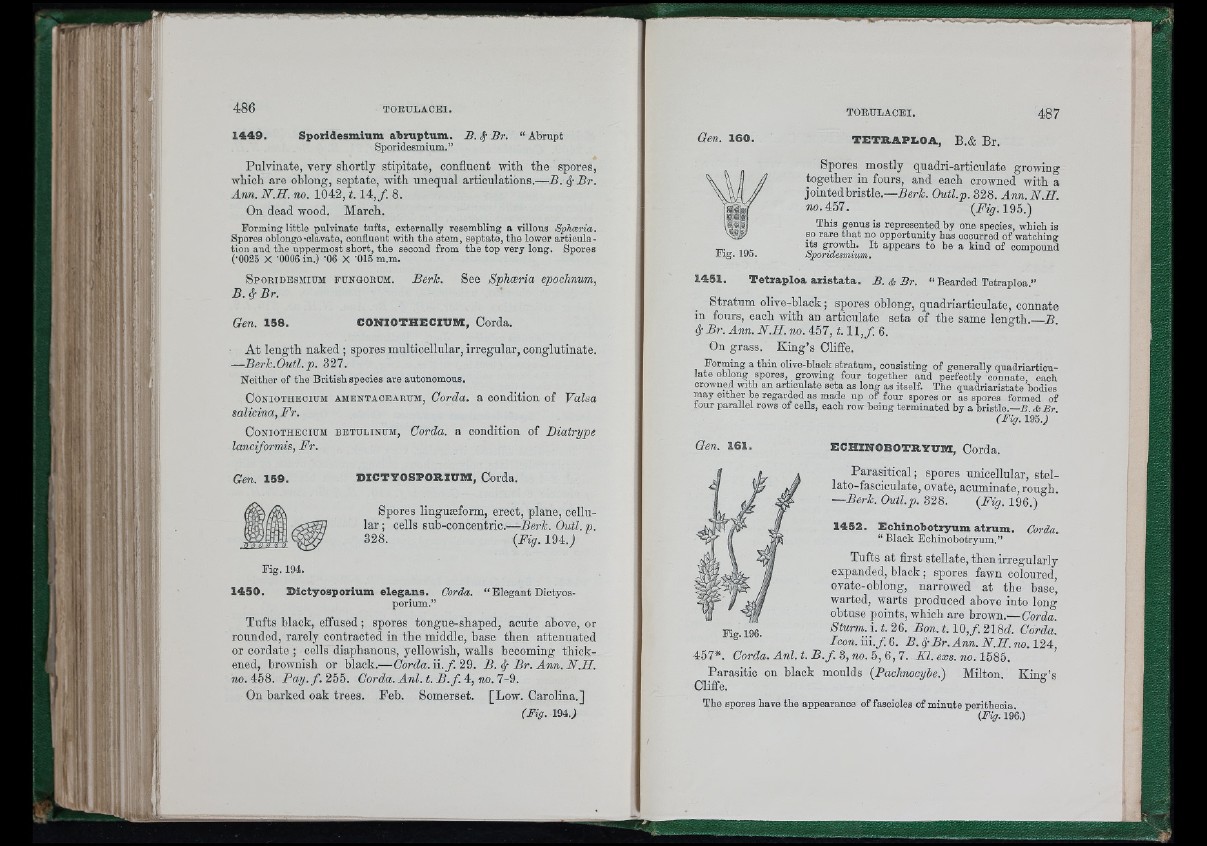
1 4 4 9 . Sp o z id e sm ium a b ru p tum . B . ^ B r . “ Abrupt
Sporidesmium.”
Pulvinate, very shortly stipitate, confluent with the spores,
which are oblong, septate, witb unequal articulations.—B. 4 B r .
Ann. N .H . no. 104 2 ,1.14, f . 8.
On dead wood. March.
Forming little pulvinate tnfts, externally resembling a villons Sphoeria..
Spores oblongo -clavate, confluent with the stem, septate, the lower articula -
tion and the nppermost short, the second from the top very long. Spores
(■0025 X -0006 in.) ’06 X -015 m.m.
S p o r i d e sm i u m p u n g o r u m . Berh. See Sphoeria epochnum,
B. 4 Br.
Gen. 1 5 8 . CO NIOTHECIVia, Corda.
At length naked ; spores multioellular, irregular, conglutinate.
—Berh.Outl.p. 327.
Neither of the British species are autonomous.
C o n i o t h e c i u m a m b n t a o b a r u m , Corda. a condition of Valsa
salicina, Fr.
C o n i o t h e c i u m b b t u l i n u m , Corda. a condition of Diatrype
lanciformis, Fr.
Gen. 1 5 9 . S IC T Y O S FO m UM , Corda.
Spores linguseform, erect, plane, cellular
; cells sub-concentric.—Berh. Outl. p.
328. {Fig. 194.;
Fig. 194.
1 4 5 0 . D ic ty o sp o z ium e le g a n s . Corda. “ Elegant Dictyosporium,”
Tufts black, effused; spores tongue-sbaped, acute above, or
rounded, rarely contracted in the middle, base tben attenuated
or cordate ; cells diaphanous, yellowisb, walls becoming thickened,
brownisb or black.— C o rd a .n .f.2 9 . B. 4 Br. Ann. N .H .
no. 458. P a y .f. 255. Corda. A nl. t. B .f . 4, no. 7-9.
On barked oak trees. Feb. Somerset. [Low. Carolina.]
Gen. 1 6 0 . T E TR A PLO A , B.& Br.
Spores mostly quadri-artioulate growing
together in fours, and eacb crowned witb a
jointed bristle.—-DerA. Outl.p. 328. A n n .N .H .
no. 457. (Fig. 195.)
This genus is represented by one species, which is
80 rare that no opportunity has occurred of watching
growth. I t appears to be a kind of compound
hig. 195. S;poridesmiu7n,
1 4 5 1 . T e tza p lo a a z is ta ta . B .& B r . “ Bearded Tetraploa.”
Stratum olive-black; spores oblong, quadriarticulate, connate
in fours, each with an articulate seta of the same length. B.
4 B r .A n n .N .H .n o .457, t . l l , f . 6 .
On grass. King’s Cliffe.
Forming a thin olive-black stratum, consisting of generally quadriartion-
late oblong spores, growing four together and perfectly connate, each
crowned with an articulate seta as long as itself. The quadriaristate bodies
may either be regarded as made up of four spores or as spores formed of
tour parallel rows of cells, each row being terminated by a bristle —B A B r
(Fig. 195.) '
Gen. 1 6 1 . ECHINOBOTRYUM, Corda.
Parasitical; spores unicellular, stel-
lato-fasciculate, ovate, acuminate,rough.
— Berh. Outl.p. 328. {Fig. 196.)
1 4 5 2 . E ch in o b o tzy um a tzum . Corda.
“ Black Echinobotryum.”
Tufts at first stellate, tben irregularly
expanded, black ; spores fawn coloured,
ovate-oblong, narrowed at the base,
warted, warts produced above into long
obtuse points, wbicb are brown.—Corda.
S tu rm .i.t.2 6 . B o n .t.l6 ,f.2 1 8 d . Corda.
Icon. iii./. 6. B .4 Br. Ann. N .H . no. 124,
457*. Corda. Anl. t .B . f .3 ,n o .5 ,6 ,7 . Kl.exs. no. 1585.
Para,sitic on black moulds {Pachnocybe.) Milton. King’s
Cliffe.
The spores have the appearance of fascicles of minute perithecia.
(Fig. 196.)